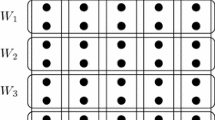Abstract
For positive integers n, k with \(3\le k\le n\), let \(X=\mathbb {F}_{2^n}\setminus \{0,1\}\), \({\mathcal {G}}=\{\{x,x+1\}:x\in X\}\), and \({\mathcal {B}}_k=\left\{ \{x_1,x_2,\ldots ,x_k\}\!\subset \!X:\sum \limits _{i=1}^kx_i=1,\ \sum \limits _{i\in I}x_i\!\ne \!1\ \mathrm{for\ any}\ \emptyset \!\ne \!I\!\subsetneqq \!\{1,2,\ldots ,k\}\right\} \). Lee et al. used the inclusion–exclusion principle to show that the triple \((X,{\mathcal {G}},{\mathcal {B}}_k)\) is a \((k,\lambda _k)\)-GDD of type \(2^{2^{n-1}-1}\) for \(k\in \{3,4,5,6,7\}\) where \(\lambda _k=\frac{\prod _{i=3}^{k-1}(2^n-2^i)}{(k-2)!}\) (Lee et al. in Des Codes Cryptogr, https://doi.org/10.1007/s10623-017-0395-8, 2017). They conjectured that \((X,{\mathcal {G}},{\mathcal {B}}_k)\) is also a \((k,\lambda _k)\)-GDD of type \(2^{2^{n-1}-1}\) for any integer \(k\ge 8\). In this paper, we use a similar construction and counting principles to show that there is a \((k,\lambda _k)\)-GDD of type \((q^2-q)^{(q^{n-1}-1)/(q-1)}\) for any prime power q and any integers k, n with \(3\le k\le n\) where \(\lambda _k=\frac{\prod _{i=3}^{k-1}(q^n-q^i)}{(k-2)!}\). Consequently, their conjecture holds. Such a method is also generalized to yield a \((k,\lambda _k)\)-GDD of type \((q^{\ell +1}-q^{\ell })^{(q^{n-\ell }-1)/(q-1)}\) where \(\lambda _k=\frac{\prod _{i=3}^{k-1}(q^n-q^{\ell +i-1})}{(k-2)!}\) and \(k+\ell \le n+1\).
Similar content being viewed by others
References
Bao J., Ji L.: Constructions of strictly \(m\)-cyclic and semi-cyclic \(H(m, n,4,3)\). J. Combin. Des. 24, 249–264 (2016).
Beth T., Jungnickel D., Lenz H.: Design Theory, 2nd edn. Cambridge University Press, Cambridge (1999).
Colbourn C.J., Dinitz J.H. (eds.): Handbook of Combinatorial Designs. Taylor and Francis Group, CRC Press, Boca Raton (2007).
Colbourn C.J., Dinitz J.H., Stinson D.R.: Applications of combinatorial designs to communications, cryptography, and networking. Lond. Math. Soc. Lect. Note Ser. 267, 37–100 (1999).
Etzion T.: Optimal constant weight codes over \(Z_k\) and generalized designs. Discret. Math. 169, 55–82 (1997).
Hanani H.: Balanced incomplete block designs and related designs. Discret. Math. 11, 255–369 (1975).
Lee C.D., Chang Y., Liu C.: A construction of group divisible designs with block sizes 3 to 7. Des. Codes Cryptogr. (2017). https://doi.org/10.1007/s10623-017-0395-8.
Yin J.: Some combinatorial constructions for optical orthogonal codes. Discret. Math. 185, 201–219 (1998).
Acknowledgements
The author would like to thank the referees for careful check and many helpful comments.
Author information
Authors and Affiliations
Corresponding author
Additional information
Communicated by V. D. Tonchev.
Research supported by NSFC Grants 11431003 and a project funded by the priority academic program development of Jiangsu higher education institutions.
Rights and permissions
About this article
Cite this article
Ji, L. Group divisible designs with large block sizes. Des. Codes Cryptogr. 86, 2255–2260 (2018). https://doi.org/10.1007/s10623-017-0448-z
Received:
Revised:
Accepted:
Published:
Issue Date:
DOI: https://doi.org/10.1007/s10623-017-0448-z




